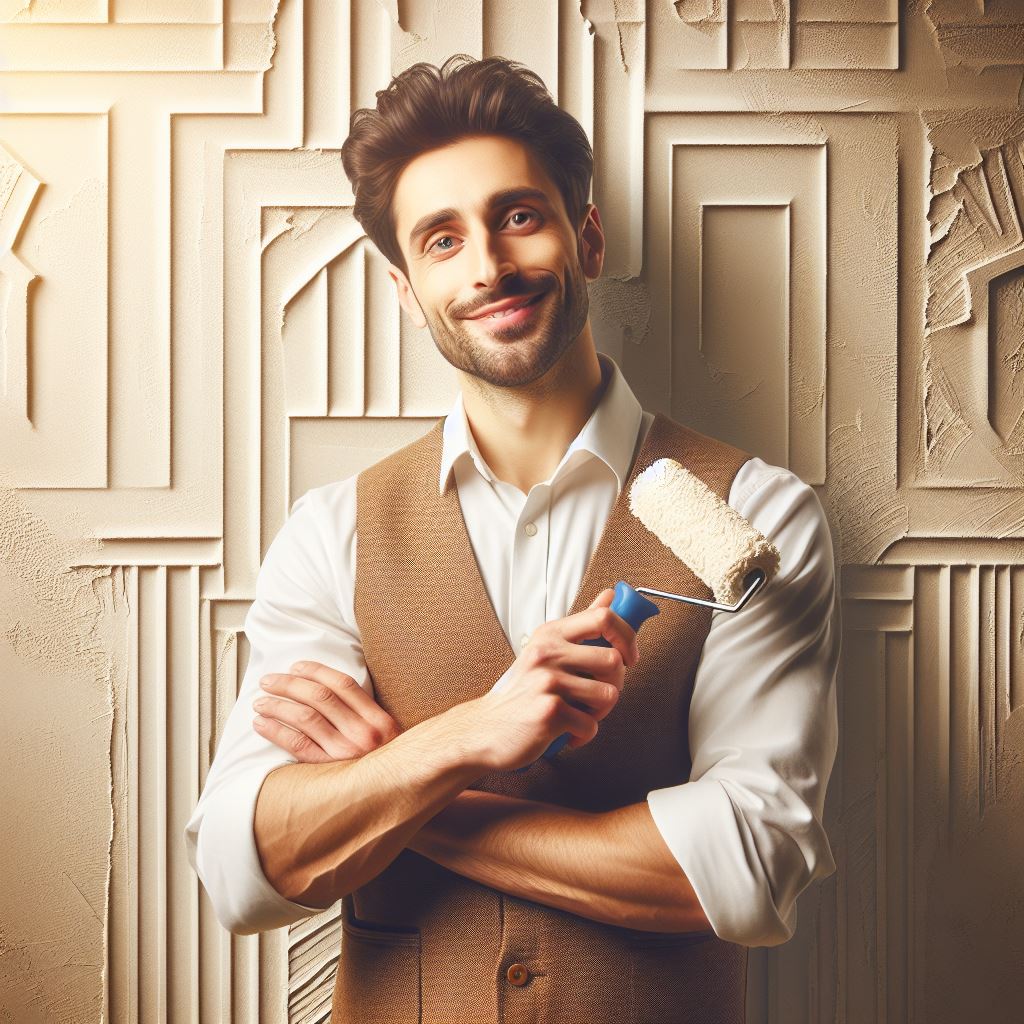Introduction to DIY Wall Texturing
A. Importance of Wall Texturing
- Enhance Aesthetics: DIY wall texturing transforms bland walls into visually appealing focal points.
- Boost Property Value: Professional-looking textures add value to your home during resale.
- Hide Imperfections: Conceal wall imperfections like cracks and dents with textured finishes.
- Create Depth: Texturing provides dimension, making rooms feel more spacious and dynamic.
- Personalization: Express your style by choosing from various textures, colors, and application techniques.
B. Advantages of DIY Wall Texturing
- Cost-Effective: Save money by tackling texturing projects yourself, cutting down on labor costs.
- Creative Control: Customize textures to suit your preferences, ensuring a unique and personal touch.
- Skill Development: Learn a valuable skill that can be applied to future home improvement projects.
- Time Efficiency: With proper guidance, DIY wall texturing can be accomplished in a relatively short time.
- Satisfaction: Enjoy the sense of accomplishment that comes with successfully texturing your own walls.
C. Overview of the Ultimate Guide
This guide comprehensively covers essential DIY wall texturing techniques, tools, and tips for success.
From surface preparation to finishing touches, follow step-by-step instructions to achieve professional-looking results.
Unlock the secrets of various texturing methods, including stippling, sponging, and combing.
Equip yourself with the knowledge to troubleshoot common issues and ensure a flawless textured finish.
Preparing for Wall Texturing
Embarking on a DIY wall texturing project requires meticulous preparation to ensure a smooth and successful endeavor.
In this section, we will delve into the crucial steps of preparing your workspace before diving into the creative process.
A. Gathering the Necessary Tools and Materials
Before you commence the texturing process, assemble all the essential tools and materials.
Ensure you have a high-quality joint compound, a trowel, a texture roller, and a mixing paddle.
Don’t forget sandpaper for smoothing, and a sturdy ladder for those hard-to-reach spots.
Having all your tools in one place minimizes interruptions, allowing you to focus on the task at hand.
B. Clearing and Cleaning the Work Area
A clutter-free workspace is essential for a seamless texturing experience.
Remove furniture and cover the floors with drop cloths to safeguard against splatters.
Dust and debris can jeopardize the texture application, so give your walls a thorough cleaning with a mild detergent and water solution.
This not only enhances adhesion but also ensures a professional finish.
C. Patching Any Holes or Cracks in the Wall
Addressing imperfections in your walls is a crucial step in achieving a flawless textured finish.
Use a joint compound to fill in any holes or cracks, smoothing the surface with a putty knife.
Allow ample time for drying, and sand the patched areas to create an even canvas.
This meticulous approach guarantees that your textured walls will not only look visually appealing but also stand the test of time.
D. Protecting Adjacent Areas with Drop Cloths or Tape
To avoid unintentional texturing in unwanted areas, take the time to protect adjacent surfaces.
Cover windows, doors, and trim with painter’s tape, and use drop cloths to shield the floor and any remaining furniture.
This precautionary measure not only preserves the integrity of your space but also simplifies the cleanup process once the texturing is complete.
By meticulously adhering to these preparation steps, you set the stage for a successful DIY wall texturing project.
The time invested in meticulous preparation will undoubtedly pay off as you move forward to unleash your creative flair on the blank canvas of your walls.
Read: Innovative DIY Home Tech Installations
Different Wall Texturing Techniques
A. Smooth Finish
1. Steps to achieve a smooth finish
To achieve a smooth finish on your walls, follow these steps
- Begin by preparing the surface, ensuring it is clean and free from any dust or debris.
- Apply a coat of primer to create a smooth base for the texture.
- Use a roller or brush to apply a thick coat of joint compound to the walls.
- Use a trowel to smooth out the compound, making sure to eliminate any imperfections.
- Let the compound dry completely before sanding it lightly to further enhance the smoothness.
- Finally, apply a coat of paint to give your walls a polished look.
2. Recommended tools and materials
- Joint compound or drywall mud
- Primer
- Paint roller or brush
- Trowel
- Sandpaper
- Paint
B. Orange Peel Texture
1. Steps to achieve an orange peel texture
To achieve an orange peel texture on your walls, follow these steps:
- Begin by preparing the surface, ensuring it is clean and free from any dust or debris.
- Apply a coat of primer to create a smooth base for the texture.
- Mix joint compound with water to create a slightly thick consistency.
- Use a paint roller or sprayer to apply the compound onto the walls in a random pattern.
- Let the compound partially dry and then lightly knock down any high points using a trowel.
- Allow the texture to fully dry before applying paint for a finished look.
2. Recommended tools and materials
- Joint compound or drywall mud
- Primer
- Paint roller or sprayer
- Trowel
C. Knockdown Texture
1. Steps to achieve a knockdown texture
To achieve a knockdown texture on your walls, follow these steps:
- Begin by preparing the surface, ensuring it is clean and free from any dust or debris.
- Apply a coat of primer to create a smooth base for the texture.
- Mix joint compound with water to create a thick consistency.
- Use a paint roller or sprayer to apply the compound onto the walls.
- Allow the compound to set for a short period.
- Use a trowel to flatten or “knock down” the raised peaks, creating a textured pattern.
- Let the texture dry completely before applying paint.
2. Recommended tools and materials
- Joint compound or drywall mud
- Primer
- Paint roller or sprayer
- Trowel
D. Skip Trowel Texture
1. Steps to achieve a skip trowel texture
To achieve a skip trowel texture on your walls, follow these steps:
- Begin by preparing the surface, ensuring it is clean and free from any dust or debris.
- Apply a coat of primer to create a smooth base for the texture.
- Mix joint compound with water to create a thick yet spreadable consistency.
- Use a trowel to apply the compound to the wall in a skip trowel motion, creating uneven patterns.
- Let the texture partially dry and lightly knock down any high points with the trowel.
- Allow the texture to fully dry before applying paint for a finished look.
2. Recommended tools and materials
- Joint compound or drywall mud
- Primer
- Trowel
Read: Revamp Your Living Room: DIY Style Guide

Step-by-Step Guide to DIY Wall Texturing
Now that you have all the necessary tools and materials ready, it’s time to start texturing your walls!
A. Preparation
1. Sanding the wall
First, prepare the wall by sanding it to create a smooth surface.
This will help the texture compound adhere better and ensure a more professional-looking finish.
2. Applying primer
Next, apply a coat of primer to the wall.
This step is important as it seals the surface and provides a better bond for the texture compound.
B. Applying the texture
1. Mixing the texture compound
Start by mixing the texture compound according to the instructions on the packaging.
Make sure to follow the recommended ratios to achieve the desired consistency.
2. Using a texture sprayer or roller for application
Once the texture compound is mixed, you can choose to apply it using a texture sprayer for a more even and consistent application or a roller for a more textured look.
Choose the method that suits your desired outcome.
C. Creating the desired texture
1. Techniques for each texture type
Depending on the texture you want to achieve, there are various techniques you can try.
For a skip trowel texture, use a trowel to create random patterns.
To get a knockdown texture, spray the texture compound on the wall, then flatten it with a trowel or knife.
For a popcorn texture, use a special brush or roller with a pre-made popcorn texture.
2. Tips for achieving consistency and uniformity
To ensure consistency and uniformity throughout the entire wall, keep a steady hand and apply the texture in small sections.
Use the same pressure and technique for each section to achieve a cohesive look.
With these step-by-step instructions and tips, you’re well equipped to start texturing your walls like a pro.
Remember to practice on a small, inconspicuous area first to get comfortable with the process, and always follow safety precautions and manufacturer’s instructions. Good luck!
Read: Small Space, Big Impact: DIY Storage Solutions
Tips and Tricks for Successful Wall Texturing
Texturing your walls can add depth and character to any room, transforming a bland space into a visually stunning masterpiece.
To ensure your DIY wall texturing project goes off without a hitch, follow these essential tips and tricks.
A. Proper Lighting and Ventilation
Before diving into your texturing project, ensure you have proper lighting and ventilation in the area.
Adequate lighting will help you identify any imperfections in the texture application, ensuring a smoother finish.
Additionally, proper ventilation is crucial when working with texture compounds to prevent inhaling fumes.
Open windows and doors, and consider using fans to promote air circulation.
A well-lit and well-ventilated space sets the stage for a successful wall texturing experience.
B. Working in Sections for Large Areas
When dealing with large wall surfaces, it’s wise to work in manageable sections.
This approach allows you to maintain control over the texture application and ensures uniformity throughout the project.
Start by dividing the wall into smaller sections, applying texture to one section at a time.
This method not only facilitates a more systematic workflow but also prevents the texture from drying out before you can achieve the desired pattern.
C. Cleaning Tools and Equipment
Keeping your tools and equipment clean is essential for achieving a professional-looking finish.
Regularly clean your texturing tools, such as rollers and brushes, to prevent dried texture compound from interfering with the application.
This not only enhances the quality of the texture but also prolongs the life of your tools.
Consider investing in high-quality brushes and rollers for a smoother application and easier cleaning process.
D. Testing the Texture on a Small Area First
Before committing to texturing the entire wall, it’s crucial to test the texture on a small, inconspicuous area.
This allows you to assess the texture’s appearance and make any necessary adjustments before applying it to the entire surface.
Testing on a small area also helps you get a feel for the application technique and ensures you achieve the desired result.
Don’t skip this step, as it can save you time and effort in the long run.
By incorporating these tips into your DIY wall texturing project, you’ll enhance your chances of achieving a professional and visually appealing result.
Proper lighting, sectioned work, clean tools, and testing are the keys to success in the art of wall texturing.
Read: Master Bedroom Makeover: DIY Essentials
Finishing and Maintenance
A. Allowing the Texture to Dry Properly
Patience is key when it comes to DIY wall texturing.
After applying the texture, it’s crucial to allow sufficient drying time before moving on to the next steps.
The drying time can vary depending on the type of texture used, humidity levels, and room temperature.
Typically, it takes anywhere from 24 to 48 hours for the texture to fully dry.
To ensure an even and durable finish, resist the temptation to rush through this stage.
Adequate drying time prevents smudges or damage to the texture, ensuring a smooth and professional-looking result.
If uncertain, perform a touch test in inconspicuous areas to gauge the dryness before proceeding to the next phase.
B. Priming and Painting the Textured Wall
Once the texture has dried thoroughly, the next steps involve priming and painting to enhance the aesthetic appeal and longevity of your textured wall.
Begin by applying a quality primer to create a uniform surface and enhance paint adhesion.
This step is especially crucial if you’re transitioning from a textured to a smooth finish.
Choose a high-quality paint suitable for textured surfaces.
A roller with a thick nap is ideal for ensuring even coverage over the textured areas.
Be mindful of the paint’s consistency, as a thicker paint can better fill in the textured patterns.
For a creative touch, consider experimenting with different color combinations or techniques to accentuate the texture’s depth.
Multiple thin coats are often more effective than a single heavy application, ensuring an even and attractive finish.
C. Regular Maintenance and Touch-Ups
Maintaining the vibrancy and integrity of your textured wall requires periodic attention.
Regularly inspect the surface for any signs of wear, scratches, or damage.
In high-traffic areas, consider applying a clear protective coat to shield the texture from potential damage.
For minor imperfections, keep a small supply of the original texture mixture on hand for touch-ups.
This proactive approach will help preserve the wall’s appearance and prevent the need for extensive repairs down the line.
By following these steps for finishing and maintenance, you’ll not only achieve a professional-looking textured wall but also ensure its long-lasting beauty.
With the right care, your DIY textured wall can be a stunning focal point in any room for years to come.
Troubleshooting Common Issues
A beautifully textured wall can enhance the aesthetics of any room, but even the most seasoned DIY enthusiasts encounter challenges during the process.
In this section, we’ll address common issues that may arise when applying texture to your walls.
A. Uneven Texture Application
Achieving an even texture requires precision and patience.
If you notice unevenness in your texture, the culprit may be inconsistent pressure or an uneven mixture.
To remedy this, ensure a uniform application by maintaining steady pressure on your texturing tool.
Additionally, double-check your mixture’s viscosity; a well-mixed texture compound ensures a smooth finish.
B. Excessive Texture Buildup
Sometimes, enthusiasm can lead to over-application of texture, resulting in a lumpy or heavy appearance.
To fix this, gently scrape off excess texture using a putty knife or a trowel.
Work in small sections, feathering the edges for a seamless transition.
If needed, sand the area lightly after the texture has dried to create a more balanced surface.
C. Cracks or Bubbles in the Texture
Cracks or bubbles can occur due to a variety of factors, such as rapid drying or improper mixing.
For small cracks, lightly sand the affected area and reapply texture, feathering the edges.
To address bubbles, carefully puncture them with a utility knife, smooth out the texture, and allow it to dry completely before refinishing.
D. Blending in Repaired Areas
Repairing a damaged section without leaving visible seams can be challenging.
Begin by sanding the repaired area to create a smooth surface.
Apply a thin layer of texture, gradually blending it into the surrounding wall.
Feather the edges to ensure a seamless transition. Multiple thin layers may be necessary for a flawless finish.
Patience is key during this step; allow each layer to dry before applying the next.
By troubleshooting these common issues, you’ll be better equipped to create a beautifully textured wall that adds character and charm to your living space.
Remember, practice makes perfect, so don’t be discouraged if it takes a few attempts to achieve the desired results.
Conclusion
DIY wall texturing is a fantastic way to revitalize your living spaces.
Choose the right texture, gather materials, prepare the surface, apply the texture, allow for drying time, sand, and finish with paint for stunning results.
Embark on this creative journey with confidence. DIY wall texturing allows you to express your unique style and breathe new life into your home.
The satisfaction of seeing your textured walls is worth the effort.
The ultimate guide to DIY wall texturing empowers you to transform your living spaces with texture and character.
Take the plunge, experiment with different textures, and enjoy the rewarding process of creating a personalized, visually appealing home.
Your walls will thank you for it!




